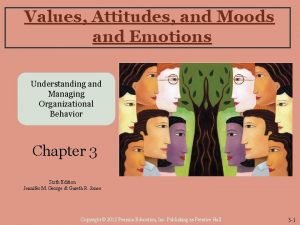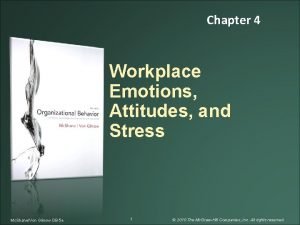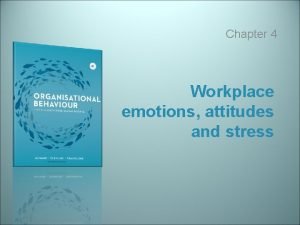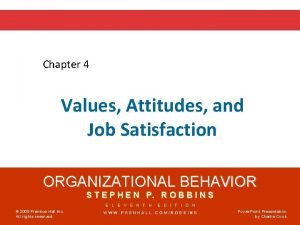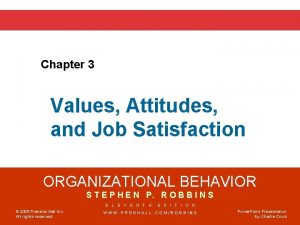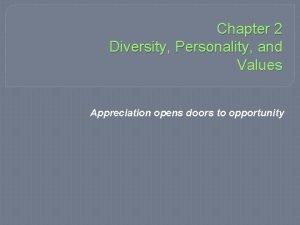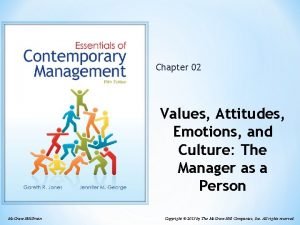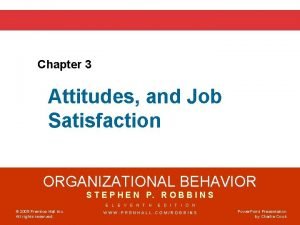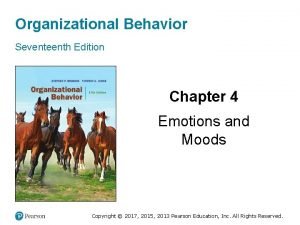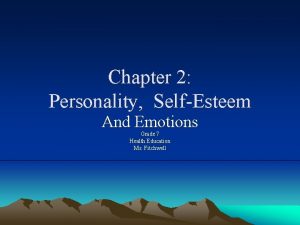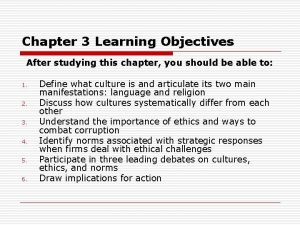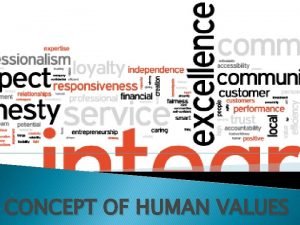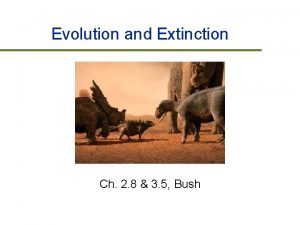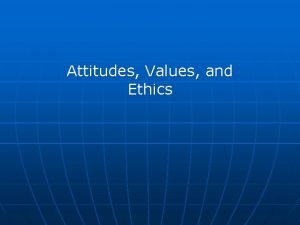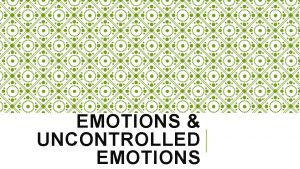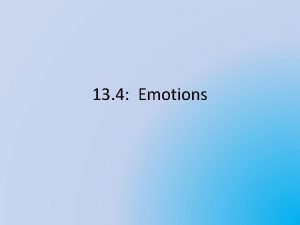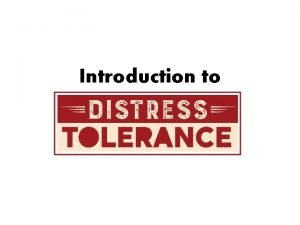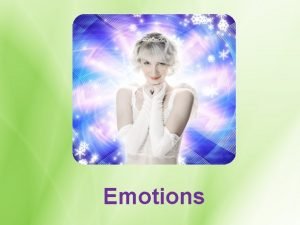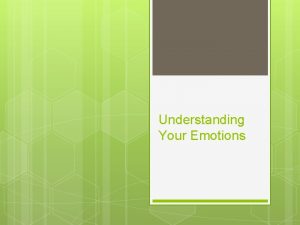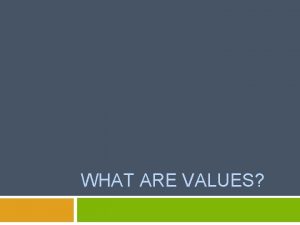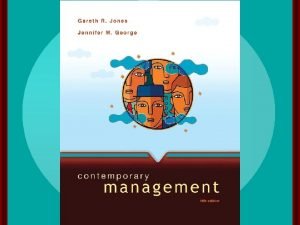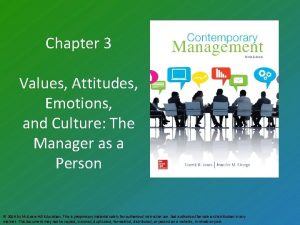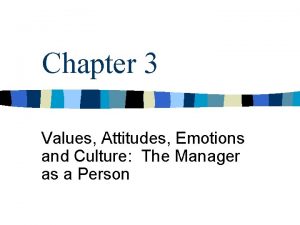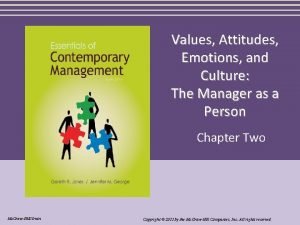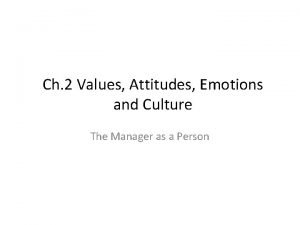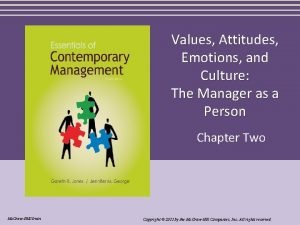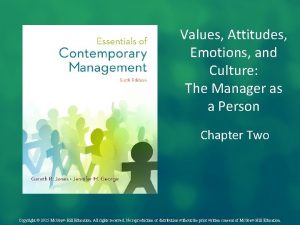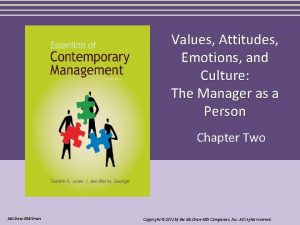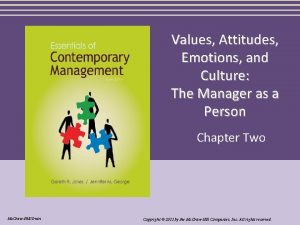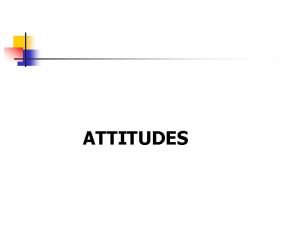SIXTH EDITION CHAPTER 3 Values attitudes and emotions































- Slides: 31

SIXTH EDITION

CHAPTER 3 Values, attitudes and emotions

ORGANISATIONAL BEHAVIOUR Learning Outcomes Define values and explain their sources Identify and describe Rokeach’s instrumental and terminal values Explain Schwartz’s basic human values model and his related work values model Explain how attitudes influence behaviour in terms of the model of planned behaviour Copyright © 2018 by Mc. Graw-Hill Ryerson Chapter 3 - 3

ORGANISATIONAL BEHAVIOUR Learning Outcomes Describe three key work-related attitudes – organisational commitment, job involvement and job satisfaction Distinguish between positive and negative emotions, and explain how they can be judged Define what emotional intelligence is and which components it implies Focus on emotional contagion in the workplace Describe what flow is and how it influences organisational behaviour. Copyright © 2018 by Mc. Graw-Hill Ryerson Chapter 3 - 4

ORGANISATIONAL BEHAVIOUR Opening Case • Venture capitalist John Moulton: o His 3 strongest character traits: determination, curiosity and insensitivity • Is insensitivity essential to survival in business? o ‘Lets you sleep when others can’t’ • Insensitive leaders = a bad reputation? FOR DISCUSSION: Copyright © 2018 by Mc. Graw-Hill Ryerson Do you agree that insensitivity (to some degree) is a necessary leadership trait? Chapter 3 - 5

ORGANISATIONAL BEHAVIOUR Values • What are values? o Standards or criteria for choosing goals and guiding actions o Relatively enduring and stable over time o Develop through the influence of personality, society and culture • Value Systems • Instrument values vs. Terminal Values Copyright © 2018 by Mc. Graw-Hill Ryerson Chapter 3 - 6

ORGANISATIONAL BEHAVIOUR Instrumental MORAL values Adapted from Table 3. 1 Rokeach’s Instrumental and Terminal Values Instrumental MORAL values BROADMINDED Open-minded HONEST Sincere, truthful AMBITIOUS Hard-working, aspiring COURAGEOUS Standing up for your beliefs CHEERFUL Light-hearted, joyful LOVING Affectionate, tender CAPABLE Competent, effective HELPFUL Working for others’ welfare FORGIVING Willing to pardon others RESPONSIBLE Dependable, reliable HONEST Sincere, truthful OBEDIENT Dutiful, respectful Source: Based on Table 2. 1 in M. Rokeach, The Nature of Human Values (New York: The Free Press, 1973), p. 28. Copyright © 2018 by Mc. Graw-Hill Ryerson Chapter 3 - 7

ORGANISATIONAL BEHAVIOUR Terminal PERSONAL values Adapted from Table 3. 1 Rokeach’s Instrumental and Terminal Values Terminal PERSONAL values FAMILY SECURITY Taking care of loved ones PLEASURE An enjoyable, leisurely life A COMFORTABLE LIFE A prosperous life SALVATION Saved, eternal life AN EXCITING LIFE A stimulating, active life SELF-RESPECT Self-esteem A SENSE OF ACCOMPLISHMENT Lasting contribution WISDOM A mature understanding of life MATURE LOVE Sexual and spiritual intimacy INNER HARMONY Freedom from inner conflict HAPPINESS Contentedness TRUE FRIENDSHIP Close companionship Source: Based on Table 2. 1 in M. Rokeach, The Nature of Human Values (New York: The Free Press, 1973), p. 28. Copyright © 2018 by Mc. Graw-Hill Ryerson Chapter 3 - 8

ORGANISATIONAL BEHAVIOUR Instrumental COMPETENCE values Adapted from Table 3. 1 Rokeach’s Instrumental and Terminal Values Instrumental COMPETENCE values INDEPENDENT INTELLECTUAL IMAGINATIVE Self-reliant, self-sufficient Intelligent, reflective Daring, creative LOGICAL CLEAN Consistent, rational Neat, tidy POLITE Courteous, well-mannered Source: Based on Table 2. 1 in M. Rokeach, The Nature of Human Values (New York: The Free Press, 1973), p. 28. Copyright © 2018 by Mc. Graw-Hill Ryerson Chapter 3 - 9

ORGANISATIONAL BEHAVIOUR Terminal SOCIAL values Adapted from Table 3. 1 Rokeach’s Instrumental and Terminal Values Terminal SOCIAL values NATIONAL SECURITY EQUALITY FREEDOM Protection from attack Brotherhood, equal opportunity for all Independence, free choice A WORLD OF BEAUTY SOCIAL RECOGNITION A WORLD AT PEACE Beauty of nature and the arts Respect, admiration Free of war and conflict Source: Based on Table 2. 1 in M. Rokeach, The Nature of Human Values (New York: The Free Press, 1973), p. 28. Copyright © 2018 by Mc. Graw-Hill Ryerson Chapter 3 - 10

ORGANISATIONAL BEHAVIOUR The basic human values model • Schwartz o 10 value types grouped according to the overall focus of the impact they have on people’s lives o Four overall directions Source: Based on S. H. Schwartz and G. Sagie, ‘Value Consensus and Importance: A Cross-National Study’, Journal of Cross-Cultural Psychology, July 2000, p. 468. Copyright © 2018 by Mc. Graw-Hill Ryerson Chapter 3 - 11

ORGANISATIONAL BEHAVIOUR Work Values • What are work values? o Expressions of basic values in the work setting 1. Intrinsic values express openness-to-change values 2. Extrinsic values refer to conservation 3. Social or interpersonal work values express self-transcendence values 4. The prestige or power values – a type added to the work values research by Schwartz – imply values related to the selfenhancement values Copyright © 2018 by Mc. Graw-Hill Ryerson Chapter 3 - 12

ORGANISATIONAL BEHAVIOUR Work Values - Activity • Schwartz developed the Work Value Survey (WVS) to measure people’s work values. • Try the activity on page 66: Which work values are most important to you? Copyright © 2018 by Mc. Graw-Hill Ryerson Chapter 3 - 13

ORGANISATIONAL BEHAVIOUR Evidence about values and application • Power, achievement and hedonism non-cooperation • Benevolence, universalism and conformity cooperation • Value congruence -fit between people’s work values and the job/organisation o Several studies found that people choose a job in accordance with their work values rather than the other way around • Values influence employees’ perception, motivation and performance, and play a role in decision-making, ethics and evaluations. Copyright © 2018 by Mc. Graw-Hill Ryerson Chapter 3 - 14

ORGANISATIONAL BEHAVIOUR Attitudes • Attitudes: o Beliefs and feelings people have about specific ideas, situations and people, which influence their behaviour • Attitudes affect behaviour at a different level from values • Attitudes are more directed towards specific goals or situations, while values are more abstract • Values and attitudes are generally in harmony Copyright © 2018 by Mc. Graw-Hill Ryerson Chapter 3 - 15

ORGANISATIONAL BEHAVIOUR Attitudes • Cognitive component o Refers to the beliefs, opinions, cognitions or knowledge someone has about a certain object, situation or person. • Affective component o Refers to the feelings, moods and emotions a person has about something or someone. • Behavioural component o Refers to how a person intends or expects to act towards something or someone. Copyright © 2018 by Mc. Graw-Hill Ryerson Chapter 3 - 16

ORGANISATIONAL BEHAVIOUR Stability of attitudes • Attitudes can change • Attitudes are more susceptible to change during early and late adulthood than during middle adulthood • Cognitive dissonance occurs when different attitudes are in conflict with each other or when people behave inconsistently with their attitudes Copyright © 2018 by Mc. Graw-Hill Ryerson Chapter 3 - 17

ORGANISATIONAL BEHAVIOUR Attitudes affect behaviour via intentions Figure 3. 2 Ajzen’s Theory of Planned Behaviour Source: Developed from Fishbein, M. and Ajzen, I. (1980) Predicting and Changing Behavior: The Reasoned Action Approach. New York, 2010: Psychology Press. Copyright © 2018 by Mc. Graw-Hill Ryerson Chapter 3 - 18

ORGANISATIONAL BEHAVIOUR Evidence about attitudes • Organisational commitment o The extent to which an employee identifies him-/herself with the organisation and is committed to its goals. • Job involvement o The extent to which the employee is personally involved with his or her work role. • Job satisfaction o General attitude the employee has towards his or her job. Copyright © 2018 by Mc. Graw-Hill Ryerson Chapter 3 - 19

ORGANISATIONAL BEHAVIOUR Application of attitudes • Evidence and Aplication: o Relationships are dynamic, with beliefs, attitudes, subjective norms, perceived control and behavioural intentions. o Can be influenced indirectly through education and training. o Clear and credible communication, organisational culture, values and role models can redirect subjective norms. o Regular employee-attitude surveys can provide important information on employers’ ideas and changes. Copyright © 2018 by Mc. Graw-Hill Ryerson Chapter 3 - 20

ORGANISATIONAL BEHAVIOUR Emotions • Key terms: o Emotions o Moods o Affect o Felt emotions o Displayed emotions Copyright © 2018 by Mc. Graw-Hill Ryerson Chapter 3 - 21

ORGANISATIONAL BEHAVIOUR Emotions Figure 3. 3 Positive and Negative Emotions Positive affectivity vs. Negative affectivity Source: Adapted from discussion in R. S. Lazarus, Emotion and Adaptation (New York: Oxford University Press, 1991). Copyright © 2018 by Mc. Graw-Hill Ryerson Chapter 3 - 22

ORGANISATIONAL BEHAVIOUR Emotional Intelligence Definition: EI is the ability to manage your own emotions and those of others in mature and constructive ways Controversy: EI may involve too many constructs, rendering it ‘preposterously allencompassing’ Copyright © 2018 by Mc. Graw-Hill Ryerson Chapter 3 - 23

ORGANISATIONAL BEHAVIOUR Emotional Intelligence Table 3. 2 Developing Personal and Social Competence through Emotional Intelligence Personal competence Social competence Self-awareness Social awareness • Emotional self-awareness • Accurate self-assessment • Self-confidence Copyright © 2018 by Mc. Graw-Hill Ryerson • Empathy • Organisational awareness • Service Chapter 3 - 24

ORGANISATIONAL BEHAVIOUR Emotional Intelligence Table 3. 2 Developing Personal and Social Competence through Emotional Intelligence Personal competence Self-management • • • Emotional self-control Transparency Adaptability Achievement Initiative Optimism Copyright © 2018 by Mc. Graw-Hill Ryerson Social competence Relationship management • • Inspirational leadership Influence Developing others Change catalyst Conflict management Building bonds Teamwork and collaboration Chapter 3 - 25

ORGANISATIONAL BEHAVIOUR Emotional Influencing • Emotional contagion o An emotional influencing process, by which people catch the feelings of others • Applied through EI: 1. 2. 3. 4. 5. Influencing Communication Conflict management Leadership Change management Copyright © 2018 by Mc. Graw-Hill Ryerson • Emotional labour o The effort, planning and control that is needed to express organisationally desired emotions during interpersonal interactions • Examples: • Smile at customers • Greet customers • Small-talk with customers Chapter 3 - 26

ORGANISATIONAL BEHAVIOUR Emotional Influencing • Emotional dissonance o The conflict between felt (true) and displayed (required) emotions • True emotions tend to leak out – especially anger • Cultural differences exist • Women are more emotionally expressive than men Copyright © 2018 by Mc. Graw-Hill Ryerson Chapter 3 - 27

ORGANISATIONAL BEHAVIOUR Evidence about emotions and emotional intelligence • Research on the relationship between affective states and workrelated outcomes is unclear and unequivocal • Research on the importance of leader happiness or sadness is contingent on type of task • Some evidence supports simple models of EI • Goleman’s version, emphasising personal and social competencies, is highly complex • Very complex models are quite difficult to assess in their entireity Copyright © 2018 by Mc. Graw-Hill Ryerson Chapter 3 - 28

ORGANISATIONAL BEHAVIOUR Flow in the workplace • Mihaly Csikszentmihalyi - What is flow? Table 3. 3 Characteristics of Flow Copyright © 2018 by Mc. Graw-Hill Ryerson Chapter 3 - 29

ORGANISATIONAL BEHAVIOUR Evidence about flow • Universal concept • Some people have traits that stimulate flow, others do not • People who enjoy their jobs, experience flow • People who are intrinsically motivated, experience flow • Having a perceived ability helps to experience flow • Self-confidence about one’s skills positively influences flow Copyright © 2018 by Mc. Graw-Hill Ryerson Chapter 3 - 30

ORGANISATIONAL BEHAVIOUR Application of flow Csikszentmihalyi five Cs 1. Clarity 4. Commitment 2. Centre 5. Challenge 3. Choice CRITICAL THINKING: Would a highly intelligent person working on very simple tasks be likely to experience flow – and vice versa for a person of medium (or low) intelligence working on very complex tasks? Copyright © 2018 by Mc. Graw-Hill Ryerson Chapter 3 - 31
 Values attitudes moods and emotions
Values attitudes moods and emotions Peter piper picked
Peter piper picked The sixth sick sheik's sixth sheep's sick lyrics
The sixth sick sheik's sixth sheep's sick lyrics Workplace emotions, attitudes, and stress
Workplace emotions, attitudes, and stress Workplace emotions, attitudes, and stress
Workplace emotions, attitudes, and stress Dominant work values in today's workforce
Dominant work values in today's workforce Biochemistry sixth edition 2007 w.h. freeman and company
Biochemistry sixth edition 2007 w.h. freeman and company New zealand values and attitudes
New zealand values and attitudes Values and attitudes in the workplace
Values and attitudes in the workplace Values attitudes and job satisfaction
Values attitudes and job satisfaction Computer architecture a quantitative approach sixth edition
Computer architecture a quantitative approach sixth edition Automotive technology principles diagnosis and service
Automotive technology principles diagnosis and service Automotive technology sixth edition
Automotive technology sixth edition Citation sample pdf
Citation sample pdf Computer architecture a quantitative approach sixth edition
Computer architecture a quantitative approach sixth edition Precalculus sixth edition
Precalculus sixth edition Rational people think at the margin
Rational people think at the margin Computer architecture a quantitative approach sixth edition
Computer architecture a quantitative approach sixth edition Instumental values
Instumental values Instrumental values
Instrumental values Chapter 3 attitudes and job satisfaction
Chapter 3 attitudes and job satisfaction Mis chapter 6
Mis chapter 6 Chapter 1
Chapter 1 Emotions and moods in organizational behavior
Emotions and moods in organizational behavior Chapter 2 personality self-esteem and emotions
Chapter 2 personality self-esteem and emotions Western vs eastern values
Western vs eastern values Two possible values of bit
Two possible values of bit What is the concept of human values
What is the concept of human values Modes of speciation ppt
Modes of speciation ppt Expressing emotions in healthful ways
Expressing emotions in healthful ways The intentional use of unfriendly or offensive behavior
The intentional use of unfriendly or offensive behavior Sixth commandment catholic
Sixth commandment catholic
